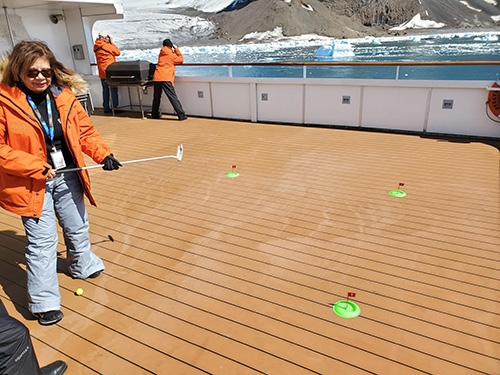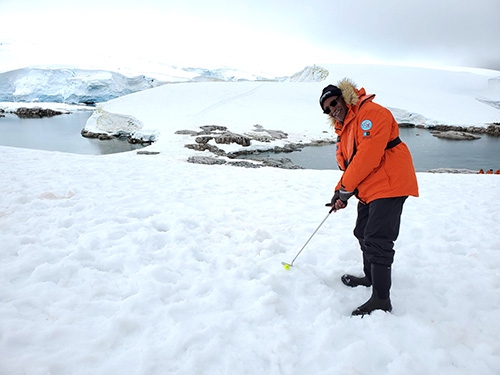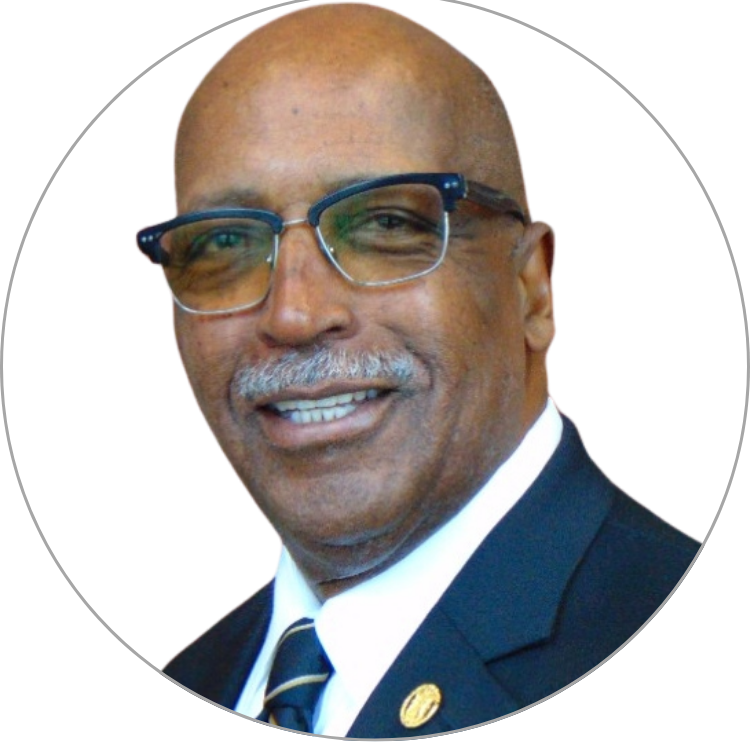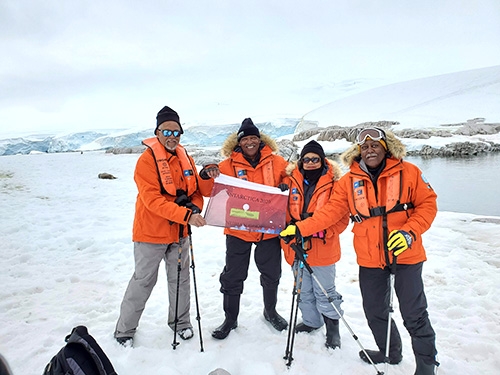
Holding their “Antarctica Nubian Open” flag (L-R) Dr. Joe Hackworth, Dr. Clyde Henderson, Mrs. Lana Hackworth, and Dr. Charles Murray Johnson.
By Clyde E. Henderson, MD, FAAOS, FHPMD (retired)
ANTARCTICA! WHY?
This is the question that this golf travel fanatic was asked repetitively as I announced my desire to visit the southernmost part of this earth. After I had been blessed to play golf in every state in America my attention turned to my next golf bucket list, every continent! My remaining three were South America, Asia, and Antarctica. Fortunately, South America is the closest continent to Antarctica, so I could knock off two destinations in one trip!
My research revealed that there are no permanent golf courses on Antarctica, even though it is the size of the USA and Mexico, combined. Why would there be when there are only 1,200 researchers in the cold harsh winter and about 5,000 in the summer? These researchers hail from the USA and up to six other countries. They break up the monotony of working on the ice-covered terrain by “playing” golf around their huts and buildings, and by playing Frisbee (disc) golf, where players throw at a target using rules similar to golf. So, with this information in hand, it was clear that my traveling companions and I would have to play our own version of Antarctica Golf. Since we have the utmost respect for the pristine and nearly unspoiled nature of Antarctica, it was decided that we would leave nothing behind, not even biodegradable golf balls.
GOLFING AROUND THE WORLD
My travel experiences around the world have revealed to me that there is a paucity of people of color, especially with golf travel. With that said, that reality is even more of a reason for us to go. It was discovered that George W. Gibbs, Jr., (1916-2000) a US Navy sailor, was the first African American to set foot on the continent of Antarctica, on January 14, 1940. On the shoulders of a Black pioneer we travel!
Understanding that the wintertime temperatures can be -100F, summer is the time to visit Antarctica. Antarctica only has two seasons: summer and winter. Because it’s located in the southern hemisphere, Antarctica’s summer is from October to February. During this time, the sun is almost always in the sky. The demand for travel to “The White Continent” is surprisingly high, so we had to wait almost two years to travel. That gave us time to maximize fitness, obtain proper attire and photography equipment, and of course, organize the “golf”.
Our expedition with National Geographic began with an overnight flight from Atlanta to Buenos Aires, Argentina. Upon arrival, we dropped our bags off at the hotel and headed off to the golf course. After 18 holes at Buenos Aires Golf Club, one of the Top 10 Best Golf Courses in Argentina, according to Trip Advisor, golf on South America, done!
We spent our next two days touring Buenos Aires before flying to Ushuaia, Argentina, the southernmost city in the world. While on the Ushuaia city tour, before boarding the ice-class ship, we took note as our tour bus passed Ushuaia Golf Club, a leading 9-hole golf course in Ushuaia.
Before experiencing the full utility of the ice-class vessel, the Drake Passage had to be crossed. It took nearly two days to traverse this segment of the Southern Ocean known for its strong waves and winds. It is the “Gateway to Antarctica.” To anyone venturing here, by sea. I recommend bringing your motion sickness medication and holding on to the ropes inside of the ship while walking around decks during the day. Amazingly, there was an abundance of sea birds following the ship, even though we were hundreds of miles from land. Among these were majestic Albatross, with wingspans of 12 feet, and giant petrels with wingspans of 7 feet.
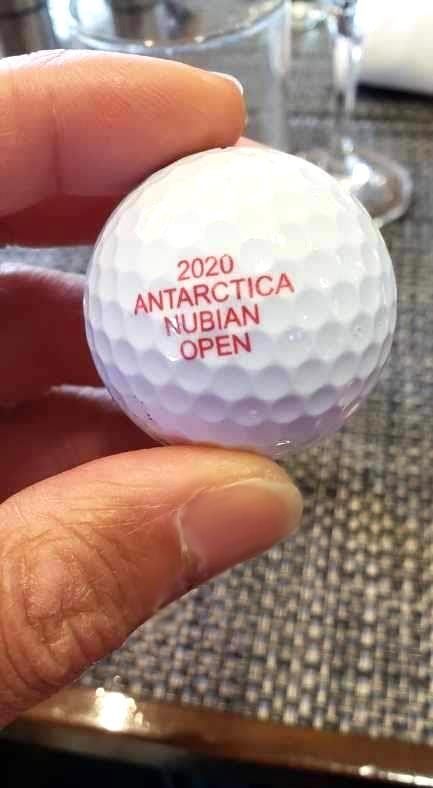
Dr. Clyde Henderson created a special 2020 Antarctica Nubian Open logoed golf ball to commemorate the amazing voyage.
The first landfall we encountered was Penguin Island in the South Shetland Island chain. Thousands of penguins and a variety of other birds were glorious to see and walk amongst after getting to land on our 12 passenger Zodiac boats.
Back at sea for a continuation of the voyage to the Antarctica Peninsula, our ship Captain emphasized that we were on an expedition and not a cruise, so we would follow the weather and not be close to the usual waterway paths of other ships. We were headed for the Eastern side of the Antarctica peninsula, into not well-charted areas. On this route, there were projected to be fewer clouds. As we passed towering glaciers and dodged huge icebergs, our destination was Danger Island and Ambush Bay! Upon arrival, tens of thousands of penguins greeted us!
LANDING ON ANTARCTICA
The next day we were projected to land on the Antarctica continent at Brown Bluff. Our “golf outing” had been cleared by the expedition leader and naturalists. Unfortunately, there was too much ice for the Zodiacs to land, so we were restricted to water cruises along with enjoying viewing fabulous penguins “porpoising” out of the water and four penguins actually swam/flew into our Zodiac. We also witnessed leopard seals voraciously feeding on penguins, seeing humpback and killer whales surfacing, and sea birds nesting, as well as their feeding on the leopard seal discarded penguin scraps—nothing goes to waste in nature. Absolutely awesome sights to see!
Being golfers “we didn’t come this far to lay up,” so the ice was not going to stop us either. We returned to the ship, which remained anchored while the remaining passengers went on the Zodiacs to enjoy the environs of Brown Bluff. My foursome broke out the designated iridescent golf ball, putting cups, and the collapsible putter and conducted the “2020 Antarctica Nubian Open” replete with a black, red, and green banner. After playing our golf on the upper deck of the ship, we celebrated with a champagne dinner and distribution of logoed golf balls.
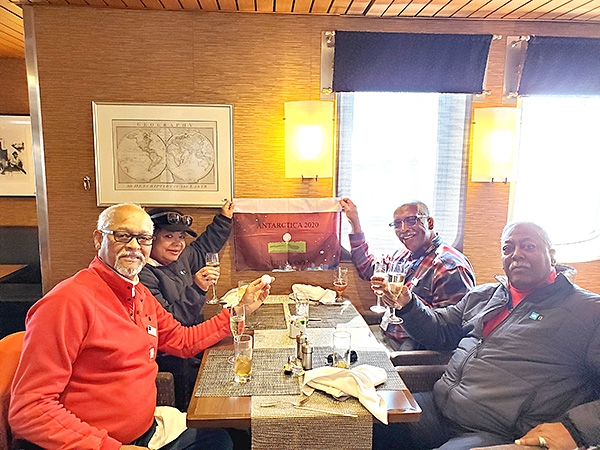
(L-R) Enjoying an onboard champagne toast is Dr. Joe Hackworth, Mrs. Lana Hackworth, Dr. Clyde Henderson, Dr. Charles M. Johnson.
We continued our expedition experiencing that every day was better than the one before. When we landed on the Antarctica islands, we walked between thousands of penguins of different species. A 6:30am wakeup call from the expedition leader awakened us, as we cruised amongst humpback whales feeding, breaching, and flapping. Kayaking amongst icebergs and Zodiac touring of sea ice fields, so close to resting seals that we could see them breathing, was incredibly memorable!
On the day after the 80thanniversary of our courageous Brother George Gibbs’ landing on Antarctica, our band of determined golfers landed at the continent’s Pilot Point where our trusted putter was assembled, used, and our Nubian Open banner was planted, albeit temporarily!
The trip back across the Drake Passage was bumpier than our first go-over, so much so that both our Captain and Expedition Leader were thrown out of their beds on this nearly 3-day return trip. We finally saw land at Cape Horn, the northern boundary of the Drake Passage where the Atlantic Ocean meets the Pacific. It truly was quite ere seeing the monument to lost sailors at this windy southernmost tip of South America.
Yes, golfers will do just about anything to play our game!
Dr. Clyde Henderson, who retired April 2, 2018 at age 66 as an orthopaedic surgeon in Cincinnati (OH) says that when he looks back on his 35-year career he is grateful for all the people who helped him along the way. (Read more…)

